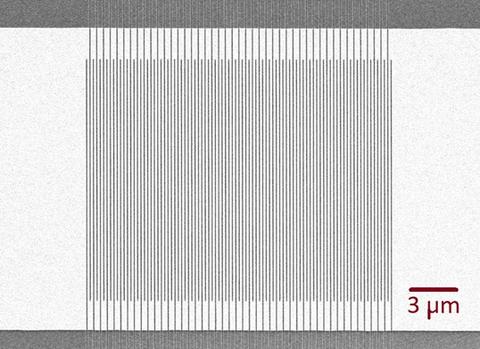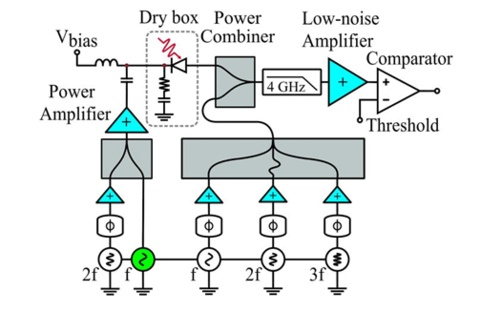Single-Photon Detectors
Single-photon detection is essential for quantum networks. NIST scientists are actively engaged in improving existing detection technologies as well as developing new ones. The paramount goal is to approach 100% detection efficiency. Other performance characteristics of detectors, such as latency, timing jitter, maximum count rate, and the presence of afterpulsing may be just as important for practical quantum networks, but may be application-specific. In some cases, the ability to resolve the number of photons in a pulse may be crucial. Thus, complete characterization of detectors is being pursued as a part of metrological efforts. Here we list major types of detectors and current development efforts.
Superconducting detectors
The superconducting nanowire single-photon detector (SNSPD) is made of a thin film of superconducting material that covers an active detection area as a meandering nanowire. The active area is typically designed to collect the output of an optical fiber. The detector is typically operated at a temperature below 2.5 K. A bias current just below the critical current (maximum supercurrent that the nanowire can sustain) is applied to the SNSPD, so that a single photon absorbed by the nanowire can locally break superconductivity, giving rise to a brief voltage pulse that can be detected. SNSPDs feature the lowest timing jitter (<3ps), high (98% or higher) detection efficiency, very low dark count rates (<10-3/second), and competitive dead times.
Transition edge sensor (TES) detectors take advantage of a very sharp dependence of resistance on temperature near the superconducting phase transition. The temperature change due to the energy of just one absorbed photon can be resolved. The temperature change due to absorption of several photons can be distinguished from that due to one photon; therefore, TES detectors are photon number-resolving, a unique feature. TES detectors offer high detection efficiency (above 98%) and the lowest dark count rate. However, these detectors have a large jitter and a long recovery time and require an extremally low temperature (~100 mK) to operate.
NIST scientists are working on improving these characteristics. In addition, significant qualitative improvements are sought, particularly photonic chip integration and multiplexing efforts are ongoing.



PI contact: Sae Woo Nam
Notable Publications:
F. Marsili, V.B. Verma, J.A. Stern, S. Harrington, A.E. Lita, T. Gerrits, I. Vayshenker, B. Baek, M.D. Shaw, R.P. Mirin, and S.W. Nam, Detecting single infrared photons with 93% system efficiency. Nature Photonics, 7, 210–214 (2013) https://doi.org/10.1038/nphoton.2013.13
Technology Readiness Level: TRL9-TRL3, from commercially available to proof of concept, depending on a device
Semiconductor detectors
Semiconductor-based single-photon detectors typically rely on the avalanche effect in reverse-biased semiconductors. These single-photon avalanche photodiodes (SPAD)s are convenient, room-temperature, low-cost, and high-performing detectors. A fairly established technology exists for detection of visible light photons, but detectors at telecom wavelengths require significant improvement. Currently, they offer a reasonable detection efficiency (~50%), although dark counts and afterpulsing are still challenges to be addressed. These issues are particularly important for high-speed quantum networks.

Improving single photon avalanche photodiode electronics
We investigate processes that affect single-photon detectors, to achieve better performance. In particular, we developed a bias gating technique that minimizes the amount of charge per avalanche so that both dark counts and afterpulsing can be greatly reduced and high count rate enabled. In this technique, the detector is biased above breakdown for very short periods of time, typically a few hundred picoseconds, at a high rate (1 GHz). At the same time, we optimize the discriminating electronics so that even a tiny avalanche signal can be detected over systematic background using the patented RF interferometry technique. This approach has been used to demonstrate that both InGaAs/InP SPADs and high-efficiency (thick) Si SPADs are capable of low-noise high-efficiency photon counting at rates above 100 million counts per second.
PI contact: Joshua Bienfang
Notable Publications:
A. Restelli, J.C. Bienfang, and A.L. Migdall, Single-photon detection efficiency up to 50% at 1310 nm with an InGaAs/InP avalanche diode gated at 1.25 GHz, Applied Physics Letters, 102, 141104 (2013), https://doi.org/10.1063/1.4801939
Patents: Joshua C. Bienfang, Alan Migdall, Alessandro Restelli, William H. Farr, Photon detector and process for detecting a single photon Patent number: 9401448
Technology Readiness Level: 7 - System prototypes in operational environment are demonstrated, but no commercial system has been developed yet.
Contacts
-
(301) 975-5887
-
(301) 975-4281
-
(240) 688-8979

